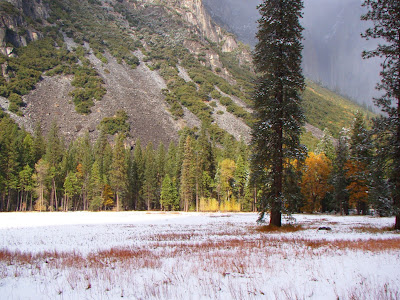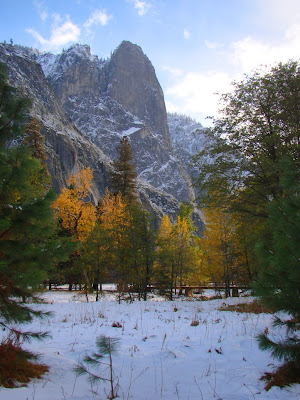California may be a leader in many things, but the fall season is not one of them. When most of the deciduous leaves in the nation have long since fallen, our fall colors are just getting started. I saw precious few fall colors two weeks ago in Yosemite Valley, but one could see they would be changing soon.
We weren't disappointed. The oaks and dogwoods where at their brightest shades of yellow and red (and yes, my readers in the eastern U.S., I know our colors can't come close to the colors out your way!). But there was a twist. We arrived on the heels of the first real snowstorm of the season. There were still occasional flurries of snow and pogonip ice coming down as we arrived in the valley.
It was just stunning to me. Yosemite National Park is one of the most beloved of my favorite places in the world, and I go there every chance I get, but in twenty years, I'm not sure I've seen it prettier than this (although I admit I seem to say that with every new season). In the picture above, the oak tree is framed by the lowest of the three Cathedral Rocks (this is the side of the rocks opposite of Bridalveil Fall). The cliff is supported by the El Capitan granite, which lacks jointing (fractures) so it forms vertical cliffs.
In the picture above, Yosemite Point is almost ignored for much of the year, because the attention of most people is drawn to Yosemite Falls, which normally plummet off the cliff just left of the center of the photo. The cliff is composed of El Capitan granite (102 million years old) and Sentinel granodiorite. The Lost Arrow is a jointed spire just to the left of the point.
Looking at Yosemite Falls, one can also miss one of the other prominent cliffs of Yosemite Valley, Sentinel Rock (above). It's on the south wall of the valley, opposite of Yosemite Falls. It is composed of Sentinel granodiorite, which is about 93 million years old.
Upper Yosemite Falls was not flowing, but enough melting snow collected in the basin below to provide a wispy flow of water to Lower Falls (320 feet).
The prominent tower in the picture above (on the right side) is one of the Cathedral Spires. I used to get them mixed up; the Cathedral Rocks are just to the west, and are much larger, providing the frame for Bridalveil Falls.
Sentinel Rock looks quite different from another vantage point.
I have no idea if this storm was "it", the final closing down of the high country. If this is another drought year, the snow could all be gone in a few days, and we could be driving over Tioga Pass in January like we did last year. Or, it could be the beginning of the buildup of a nice snowpack that could ease our drought worries here in California. All I know is that it was an indescribably beautiful day (despite my efforts to describe it anyway...).
Next up: the birds of the day, and the sunset...












2 comments:
Such amazing contrast with the fall colors and snow. Sure hope it's just the beginning.
Thanks so much for such wonderful pics!
Post a Comment